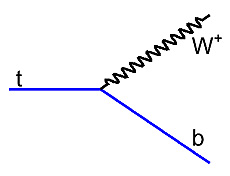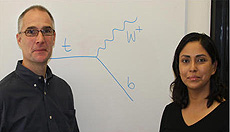|
Editor's note: Starting this year, Fermilab Today will bring you more results from research at the Energy, Intensity and Cosmic Frontiers. We will publish these results on Thursdays and Fridays, highlighting the full breadth of Fermilab's experiments.
An important vertex
 |
In the Standard Model, the top quark almost always decays to a W boson and a b quark
as shown in this diagram. The specifics of the tWb interaction at the decay vertex affect the kinematics of the W boson and b quark. So by measuring these kinematics in the CDF II detector,
we can learn something about the physics at the tWb vertex.
|
The top quark was first observed in the Tevatron Run I (1992-1996) data sets collected by the CDF and DZero experiments at Fermilab. Because the mass of the top quark is large, beyond-the-Standard Model physics contributions can affect the top quark phenomenology in a wide variety of ways: The way it is produced can be affected; the way it decays can be affected; its intrinsic properties can be changed; or new particles can mimic a top quark decay and confuse our experimental measurements. Thus a principal goal of the Tevatron Run II (2001-2011) program, which produced data samples 100 times larger than Run I, was to explore thoroughly the properties of the top quark. Recently the CDF collaboration submitted a paper for publication that describes a measurement of top quark decays that uses the full Run II data set and is sensitive to potential new physics contributions affecting the top quark in a variety of ways.
At the Tevatron, top quarks are predominantly produced in pairs and are predicted to almost always decay into a W boson and a b quark (see top figure). The object of this measurement is to test the physics of the top-W-bottom (tWb) decay vertex in detail.
Other quarks, which are much lighter than the top quark, have longer lifetimes and interact with other quarks before decaying. These additional interactions complicate our efforts to understand the physics at the decay vertex. But the top quark is a different story. Because of its very large mass and therefore its very short lifetime—a trillionth of a trillionth of a second—the top quark does not have enough time to interact with other particles and thus decays as a "bare" quark. So the top quark decays used in this analysis provide very clean tests in which to measure the physics of the tWb vertex and compare it to Standard Model predictions.
The methodology used is similar to the one employed in our previous version of this analysis, which used only 2.7 inverse femtobarns of CDF data. The current analysis is based on a data sample that's about three times larger and yields the most precise single-channel measurement to date from the Tevatron. Alas, the data are fully consistent with the Standard Model predictions and indicate that the tWb vertex behaves just the way we thought it did. Future insights are expected from similar measurements at CDF using different top quark final states, from DZero and from the LHC experiments ATLAS and CMS.
Learn more
—edited by Douglas Glenzinski and Andy Beretvas
 |
These CDF physicists contributed to this data analysis. From left: Doug Glenzinski (Fermilab) and Mousumi Datta (Fermilab and Hampton University, Hampton, Va.).
|
|